|
Phonemes are classified in vowels plus 4-5 types
of consonants besides location for articulation. The number
of types in itself points to an interpretation in accordance
with the dimension model, as naturally the views on the
speech organs in preceding file.
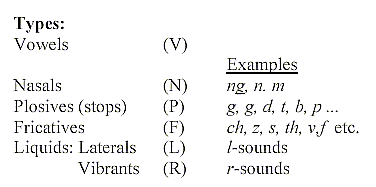
Polarities:
Polarities used by phoneticians are vowels /
consonants (without versus with outer barriers for
the air stream), voiced / voiceless (with/without
vocal cord vibration), instantaneous /continuous
sounds, and degree and kind of barrier. With these concepts
the types may be derived through 5 polarization steps as
in figure at end of this file.
Here a bit different derivation chain
is suggested, from the aspect of the main medium, the air
current, and its polarizations:
5 polarizations of the air current:
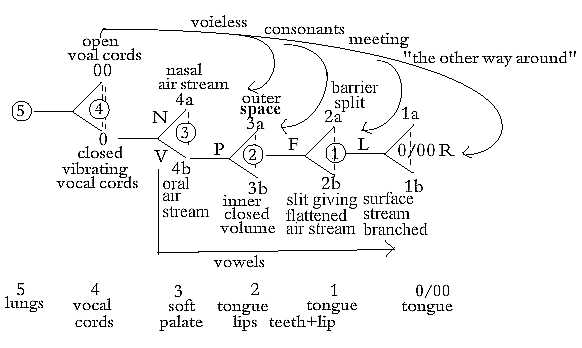
Described from the aspect of lower d-degree polarizing
the next higher one:
5 — 4: The air current
as "a whole" polarized by vocal
cords in two phases: open (V-formed) ~ 00-pole, undefined
(no sound) and closed (~ 0-pole, with vibration): voiceless
- voiced sounds as anticenter versus centre.
4 — 3; The air current
as outward directed vector field divided by
soft palate (pole 3a inwards) in two directions: upwards
nasal cavities (pole 4a) and outwards the oral cavity (pole
4b). Soft palate closed: vowels defined, when open:
nasals indirectly defined through next step (inwards).
3 — 2: The air current
as volume divided by tongue or lips in inner
closed room / outer open space, poles 3b/3a Momentary opened
volume: plosives defined.
2 — 1: The air current
as a surface, a flattened,laminar stream,
through "half" opening of volume, branched in
Space by the tongue: liquids defined.
1 — 0/00: The air current
as "linear" polarized in Time by
the tongue tip as a "point" into motions (0 /
00): vibrants defined..
We may note in the figure above that r-sounds (R)
by phoneticians are described as changes between voiceless
plosives and vowels,
There is a similar but momentary combination
of 0- and 00-poles in the vocal cord plosive (a phoneme
in some languages).
The outer poles 0-00 of d-dgree 4 in our
model - here related the vocal cords, meet in last d-degree
0/00 of motions, however as repetition. This opposition
momentary / repeated becomes one expression for the
poles 0 and 00.
(The V-form of open vocal cords implies
"motions from each other" defining an anticentre,
the 00-pole.)
Vibration, the motional moment assumed in d-degree
4 as expression for the 1 lost d-degree in structure, returns
in this last step 1 → 0/00
in the r-sounds, the vibrants.
In a derived sense there is also the 0/00-combination in
the middle step 3 —2,
the momentary transition from inner to outer air volumes
in plosives.
Hence, it gives reason to apply the view
on a dimension chain as "haploid", with double
directions from centre and anticentre meeting in step 3-2,
a new complex centre. (This seems also to agree with the
"inverted" relation circular/radial in the middle
step.)
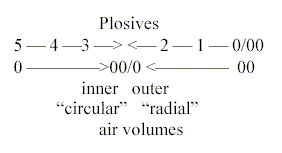
Plosives and Fricatives:
Plosives include a transition from stop to radial explosion:
a division in both space and time, which illustrates that
each step represents d-degree 1 or step 1 →
0/00. (Compare the many phoneme combinations gr-gl-gr-gl
in words.)
This middle step, with the further polarizations
to fricatives and liquids could illustrate the particle
/ wave duality of light
among elementary particles as suggested in files about physics.
(A closed potential breaking up, polarized in Space and
Time.)
The anticentre pole (00) from vocal cords, representing
at first the undefined environment for sounds, becomes stepwise
defined from outside inwards by more and more barring biological
organs, the anticentre pole in relation to the air medium.
Exhalation and secondarily the vowels
as an outward-directed vector field from the centre gets
also quantified by barring from the biological anticentra
that give the consonants:

Vowels as an underlying field level, transformed into intervals
on superposed level. Vowels as d-degree steps, consonants
as d-degrees, borders.
Compare vowels with verbs, as open, "radial"
structures, and consonants with nouns, more or less closed
structures.
Nasals: as "4a"-pole:
The "a-poles" have characters from inward direction
from anticentre in our model.
It's obvious that the nasals get defined
in inward direction, with the prerequisite of a total barrier
in d-degree step 3-2.
Variable interpretation of phonemes as out of a dimension
chain:
Half-step shifts in the alternatives could depend on whether
we look at the main axis for d-degrees of structure as representing
the dimension chain, or the outer poles in the different
d-degrees as such.
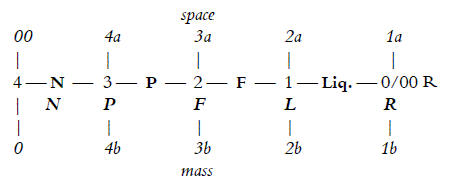
The approach is shifted, depending on whether one looks
to the geometry of the organ barriers, or to geometry of
the air current. With one example: looking to the organ
barrier, total barrier (stop) may be interpreted as a surface
(d-degree 2), polarized in the "½" barrier
of fricatives, where it's the air current that gets the
character of a surface.
Nasals - Laterals: the dimension model as "loop
model":
The loop model implies that debranched degrees in dimension
degree steps outwards are debranched and meet the other
way around inwards.
The dimension chain viewed vertically gets three steps of
polarizations of a 5-dimensional unit.
5 → 3 <—;>
2
5 → 4 <—>1
5 → 0 <—>
00
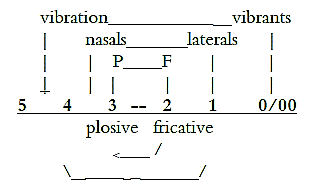
As there is a link between vibration of the
vocal cords 0 <===> 00 and vibrants, the r-sounds*,
there is also a similarity between the branched air current
in nasals and the laterally branched air current by the
tongue in liquids. And the pair plosives - fricatives merge
or transform easily into one another.
*(The sound called "flapped r"
could be compared with the vocal cord plosive.)
In terms of lower d-degrees branched off from the higher
d-degree steps:
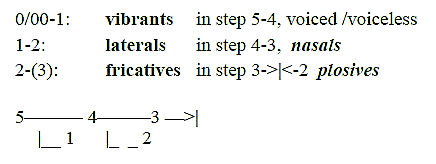
Number of phonemes:
Naturally, it's difficult to draw exact borders between
many phonemes, with variations in the pronunciation within
a language. Yet, sense-dividing phonemes are obviously quantified.
Number in the International alphabet:
Two sources are referred to below, (CE) and (BS)
.
Mean value of phonemes in a language is said to be about
30,
30 = the sum of poles in the dimension chain in our model,
2 x (5+4+3+2+1).
Vowels:
25 vowels = 52 = square of intervals in a dimension
chain (CEL).
(BS) counts on 20 vowels (5 x 4), plus 8 variables
= 28.
Consonants:
61 according to (BS), without implosive stops and
click sounds, which (CEL) includes. With addition
of two labial-velar stops from (CEL) the number becomes
63.
(Counting with 63 consonants and 28 vowels the quotient
becomes 32/22.)
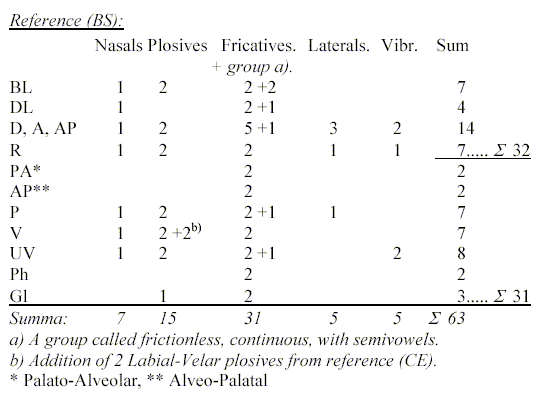
Sums in the table above may be compared with the 2x-series
in polarizations outwards: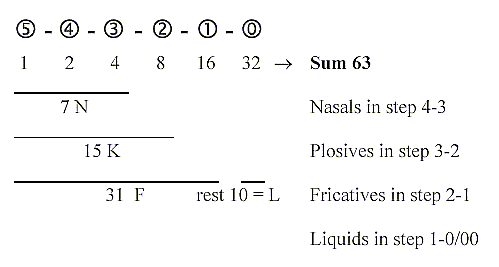
Barriers as "halvings" of barriers, simplified:
Oral vector field:
3-2: whole barrier in plosives (inner/outer)
2-1: halved in fricatives (up/down)
1-0/00- branched in Space in liquids - laterals (right/left)
0/00- branched in Time in vibrants
Apprehended as a chain of halvings, the phoneme chain reminds
of the assumed angle steps in a dimension chain.
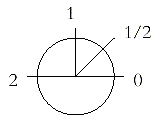
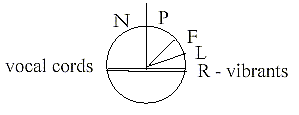
Compare spin, attributed elementary particles as fermions
and the bosons, the quanta of forces: ½ - 1 - 2.
fermiones - photons - gravitons. Nasals as with spin 2 !?.
Phonemes are naturally quanta of forces
on the level of speech.
Coordinate axes:
The three main coordinate axes of an embryo
and in developed speech organs can be identified as
a) ventral - dorsal, from vegetative -
animal poles, from throat to mouth/nose openings, front
- back, inner - outer.
b) up - down, low - high,
c) left - right.
For an upright human they are easiest to call x - y - z
respectively.
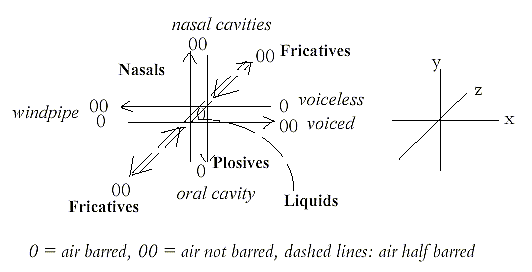
- Vowels (V) require divided y-axis.
- Nasals (N) requires divided x-axis.
- Plosives (P) requires divided y- and x-axes.
- Fricatives (F) requires only half division of the x-axis
and marks the whole z-axis.
- Liquids as laterals (L) and vibrants (R) requires divided
y-, x- and z-axes.
Fricatives - Liquids:
Fricatives and liquids may be described as complementary
in the relation between organs and air current. In the figure
below the organs are regarded as centres (c) , the air current
as anticentre (ac):
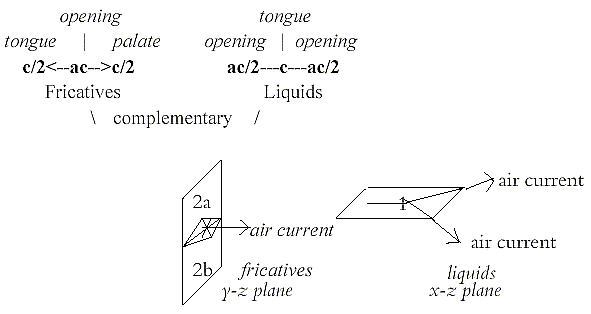
Liquids and fricatives as complementary poles can in this
case be regarded as different branches from step 2 - 1,
with one inwards step 3 - 2 according to previous possible
aspects on the model:

In inward direction, it is the centre that gets polarized,
in outward direction the anticentre.
h-sound, step 5 - 4, and semivowels j-w:
 h-sound,
with the vocal cords only half closed, lies a half step
deeper than the vowels with their vocal cords vibration,
and it can be regarded as having the lungs as primary centre.
Hence it derives from step 5 - 4 in these interpretations,
but comes up in the step 3 - 2 in the chain of phoneme types:
postpositive in aspirated plosives as aspiration. h-sound,
with the vocal cords only half closed, lies a half step
deeper than the vowels with their vocal cords vibration,
and it can be regarded as having the lungs as primary centre.
Hence it derives from step 5 - 4 in these interpretations,
but comes up in the step 3 - 2 in the chain of phoneme types:
postpositive in aspirated plosives as aspiration.
It represents the very least barrier for
a sound.
The semivowels w - j:
The vowels u and i have been called semivowels
and borders on the voiced fricatives in English, the w-sound
and j-sound, described as the two most vowel-like
consonants.
(j and - w are in Egyptian
depicted as i and u.)
- The u-sound meets the half barrier of the lips
in the w-sound, as "another way around"
in dimension chain of positions, as a meeting between complementary
poles of organs 0 ><00 between the vocal cords and
lips, 0/00 on the organ level I. As does the h-sound
in aspirated lips sounds b, p.
- The i-sound meets the j-sound on the organ
level II of the tongue, in step 3-2.
h-sounds - vowels (V) - the vibration from the internal
organs centres emerging in the external steps:
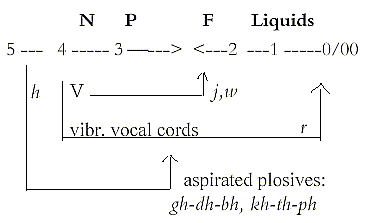
h-sound, semivowels, vibration from inner organ
centra turn all up in outer steps, types and regions. (Cf.
the loop model.)
h - semivowels and liquids: these sounds as h
- u - i - r - l can form a "whirl"!
Tongue shapes as d-degrees 3-2-1-0:
As said in file about speech organs the tongue shapes may
be described
- as more massive, 3-dimensional,
- as flattened to a tongue-blade, 2-dimensional,
- as more linear, 1-dimensional,
- or with the tongue tip as a "point", 0-dimensional
These forms correlates firstly rather well with types of
phonemes, secondarily also with positions of articulations:
Regarding types, tongue as massive in
inner nasals, plosives, as flattened in fricatives, as more
linear in liquids and as a tip in vibrants, illustrating
d-degrees 3-2-1-0.
- In plosives, in the opening phase, the tongue
is contracted to a 3-dimensional mass, in the preceding
stop phase a bit more 2-dimensional, a barrier.
- In fricatives the tongue-blade as a 2-dimensional
surface may be convex or concave, one of the geometrical
polarities of poles of d-degree 2 in our model.
As convex, it creates the sounds with
dorsum, its upper surface. As concave it forms sounds with
under side of the tip, so in "retroflex" sounds.
The upper side of the tongue is often also scooped, i.e.
concave to a wider or narrower canal for the air current.
- In liquids the tongue is narrowing, as to
illustrate the linear 1st dimension.
- In vibrants only the tip of tongue will
be used, as a point illustrating d-degree 0.

[Here, as in the interpretation of the speech organs,
it's possible to regard the step 1→0/00
developed within step 3 —
2 as inwards from d-degree 2. This could also give an
aspect on the positions for the tongue phonemes:
 ]
]
The similar differentiation in locations of articulation
from inside outwards appears as secondary developments within
phoneme type steps, which could be interpreted as two levels
of differentiations:
It would be possible to trace features
from d-degree 4 and 3 in those levels: phoneme types as
fundamentally differentiations of directions, from d-degree
4, and positions as differentiation in space, d-degree 3.
Positions:
According to the file about the speech
organs interpreted as a dimension chain:
The scientific abbreviations for locations where the
sounds are generated:
BL - Bilabial - Lip sounds
DL - Labiodental - lip-dental sounds
DA - Dental-alveolar - the inside of the teeth-dental ridge
A - Alveolar - dental ridge
AP - Alveolar-Palatal - dental ridge - hard palate
P - Palatal - hard palate, middle of the palate ceiling
V - Velar - soft palate
UV - Uvular - uvula
Gl - Glottal - larynx, vocal cords
(A couple of positions, retroflex R, and pharyngeal Ph omitted
here.)

Approximate positions for Swedish Phonemes:
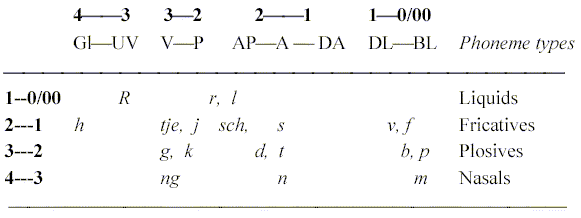
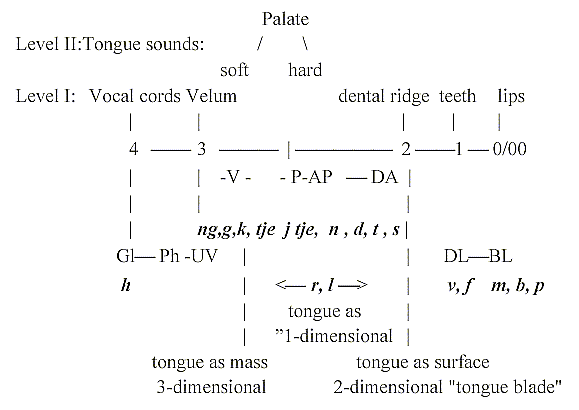
One annotation:
A dimensional interpretation of rear lingual sounds with
tongue drawn inwards (both vowels and consonants), holds
a general ambiguity: they can be understood as the necessary
way to illustrate higher d-degrees in the chain of positions
- or as a dimensional expression for inward direction in
that chain. The first alternative is the most alluded to
above
—————————————
A note:
5 polarizations, departing from polarities: vowels/consonants,
voiced/voiceless, momentary/continuous:
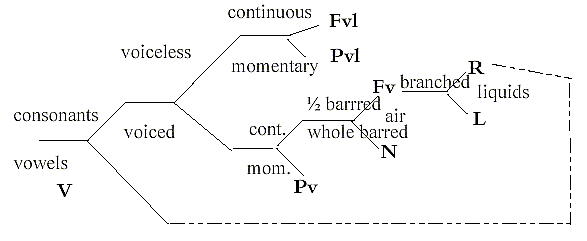
*
To Vowels
and Morphemes
To Semantic
roles of phonemes
To Sound shifts
|
















 ]
]


